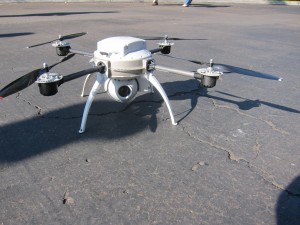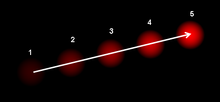
Datron Scout Air Reconnaissance System (ARS) Backpackable/Manpackable Lightweight Quad-Rotor VTOL Micro Air Vehicle (MAV)/SUAS/UAV for Tactical Surveillance Missions
When was the last time you thanked your inner ear? Probably not after riding a roller coaster or getting carsick, but what we sometimes curse and so often take for granted is nonexistent in insects such as flies. Flies lack the fluid in their head that helps us determine up from down, and yet, they still manage to fly on and navigate very complex courses. This fact has lead scientists to question how flies are able to orient themselves in space and move through obstacles.
Vision is incredibly important to flies, but they see in a much different way than humans. Instead of having an inner ear to help them differentiate up from down, they are able to sense the intensity of light and create an “artificial horizon.” Basically, the sky is always slightly brighter than the ground and insects have learned to keep the brightest part of their “horizon” on top. Their eyes are even sensitive enough to apply this ability at night! Insects also employ what is known as optic flow, which researchers are keen to understand and implement in small UAVs. Optic flow is the rate of visual motion across the retina measured in radians per second, or in more physical terms, the pattern of motion due to the relative speeds of the surrounding objects and the observer. A good way to think of this is if you imagine yourself sitting in a moving car. If you look forward, out through the window, there is a sign half a mile up ahead in the road. Although you may be travelling at say… 60mph, the sign does not appear to be moving that fast. However, once you are almost next to the sign, it suddenly appears to zoom by your window. Essentially, optic flow is the ability to judge distance based off of this relative movement. An object that is far away appears to move more slowly relative to an object that is closer.
 Optic flow is key to an insect’s ability to navigate complex obstacles. However, it is not yet understood how insects are able to process all of the information they receive and then utilize it to avoid objects; such as your favorite fly swatter! I’m sure that everyone has tried to swat a fly only to slap your arm in vain. Flies have fixed eyes, meaning they cannot move independently, but they are still able to take in optic flow from nearly every direction due to their shape and location on the head. This means that they can sense your hand and determine that it is traveling towards them as soon as you move, giving them the time they need to escape. Insects are also able to judge how fast they should travel based off of the amount of information that they are gathering. As is seen in the images below and above, if the amount of optic flow becomes too great or too fast, the insect knows that it needs to turn away or slow down in order to avoid a collision. This also means that if the insect wants to hover in place, it simply needs to have an optic flow of zero.
Optic flow is key to an insect’s ability to navigate complex obstacles. However, it is not yet understood how insects are able to process all of the information they receive and then utilize it to avoid objects; such as your favorite fly swatter! I’m sure that everyone has tried to swat a fly only to slap your arm in vain. Flies have fixed eyes, meaning they cannot move independently, but they are still able to take in optic flow from nearly every direction due to their shape and location on the head. This means that they can sense your hand and determine that it is traveling towards them as soon as you move, giving them the time they need to escape. Insects are also able to judge how fast they should travel based off of the amount of information that they are gathering. As is seen in the images below and above, if the amount of optic flow becomes too great or too fast, the insect knows that it needs to turn away or slow down in order to avoid a collision. This also means that if the insect wants to hover in place, it simply needs to have an optic flow of zero.

Engineers are trying to develop hovering drones that can fly into small spaces in order to locate disaster victims, scout out caves, or even spy, but they are limited in their ability to actually navigate these tight spaces. Most UAVs are controlled using radar, lidar, or GPS, but the signals may be unable to reach the drone in enclosed areas and the equipment is also too heavy for something that is supposed to be a small, maneuverable, hovering drone. This is where optic flow sensors come in. However, one of the main challenges is figuring out how to get a computer to mimic the retina, allowing it to “see.” For example, in the picture of an optical flow vector of a moving object in a video sequence below, a computer is unable to tell the difference between whether or not the ball is moving to the right, or if the drone is moving to the left. This is a critical piece of information for navigation! Although there has been much advancement in the understanding of optic flow, bio-inspired sensors are still in the early stages of development and an imperfect technology. But it still goes to show just how much can be learned from insects and animals not just in terms of flight, but also in terms of flight control!
understanding of optic flow, bio-inspired sensors are still in the early stages of development and an imperfect technology. But it still goes to show just how much can be learned from insects and animals not just in terms of flight, but also in terms of flight control!
This video is a cool example of the diversity of abilities that small, quad-rotor robots have due to their maneuverability.
Citations:
A hovercraft robot that uses insect-inspired visual autocorrelation formotion control in a corridor, Sawyer B. Fuller and Richard M. Murray, December 7-11, 2011
Optical Flow, Centeye, inc.,
Nature’s Flyers: Birds, Insects, and the Biomechanics of Flight, David E. Alexander, 2002
One Comment
Lorena Barba posted on December 5, 2012 at 3:05 pm
I’m only half-way through and I had to say it “this is an excellent post!” … now back to reading the rest of it.